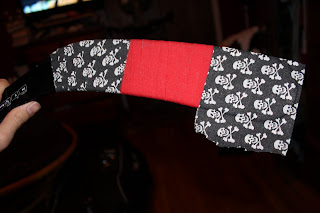Skates are the most important piece of equipment you wear. They effect everything to do with your ability to play. Because of this it's very important to spend time and think about which skates to use. My skate collection is pretty comprehensive, and not quite ridiculous. At least once you consider I play on 3 different types of surfaces. Thanks to upgrades, most of them are fairly new. Here's a run down of the current skates I use. I'll spare you from reading about my old terrible skates. That's for another post on what happens when you DON'T spend time thinking about what you strap on your feet.
Outdoor Skates
These are the Bauer Vapor XVR Lite's. I bought them off of
inlinewarehouse.com about 2 years ago mostly because they were on sale. They're no longer made, so you would have to get a newer model. Not that you would want these anyway, as I mostly got them because I was still new to playing and wanted to get things on a budget.
The bearings they came with were ABEC 7 and the wheels were Hyper Razors, which are multisurface 78A hardness wheels. Once I joined the indoor roller league at Hot Skates earlier this year, I swapped out the bearings for ABEC 9s. I highly suggest this for any roller hockey player. You don't want to be left in the dust because of your bearings when in a league.
Right now the wheels are Rink Rat Hot Shot XXXs, which are soft wheels for indoors. This is strictly because I had used the skates indoors earlier this year for my roller league. Once I bought a new pair of skates specifically for the indoor league, the Vapor XVRs became my outdoor only skates, but I didn't care if the wheels wore down so I kept them in there. The downside is I can really feel these wheels sliding. It might be because they are so soft. Once I wear them down a bit more, I'll change out the middle 2 wheels with my old Hyper Razors for a more balanced hardness.
Indoor Skates
As mentioned above, I previously was using my Bauer Vapors for both indoors and outdoors. Once I got sick of switching the wheels every week, I decided on purchasing a new pair specifically for the indoor league. After a long study of what was out on the market, I purchased Mission Solder SEs for a few reasons.
Originally I was thinking of purchasing another Bauer Vapor skate since I'm a real big fan of their design, both lightweight and aggressive stance. But Mission was recently purchases by Bauer, confusing since Bauer is also in-turn owned by Nike. Back on topic though, this model of Mission skates were the first ones made using similar molds to that of Bauer. Even the sizing is the same, whereas previously Mission skates using a different sizing model. Because of the similarity, I was willing to switch over.
The Soldier SEs are right in the middle of Mission's skate line. Even at the mid-tier though, they still come with ABEC 9 bearings and Rink Rat Hot Shot XXX wheels. These were the same specs of what I had in my Bauer's, so it would be an easy transition.
Ray has also recently purchased these skates too the previous season. His opinion of them being a pretty good skate and a great deal was enough to convince me. If you want a more detailed review, you can also check out this
video from inlinewarehouse.com.
Oh one other big reason I got these too. These skates had just gone on sale! At the time the newest model of Mission skates, the Axiom line, were just announced. The price for these skates dropped by $30, so I figured it was worth getting.
Ice Skates
Being the fan of the Bauer Vapors I already owned for roller, I figured I would get the same for ice. I had read that
Bauer Vapors were the most popular skate in the NHL. After seeing that I knew what I was going to buy when I upgraded my skates for ice hockey.
I ended up getting the Bauer Vapor X:30s. These are also mid-tier skates, ranging about $180 currently. Ice skates tend to be a little more expensive than inline skates. I'm not exactly sure why, but I suspect it's because they have to be a bit more stiff. For an in-depth look, you can check out the
video from icewarehouse.com.
The Vapors are a great line. They're ultra lightweight, so you'll get that quick jump when in a foot race. They also have a very aggressive stance which you can slightly notice. These skates are made to be worn when you're in the forward leaning position, the typical stance to balance yourself when skating.
All Bauer skates come with Tuuk blade holders since they make them. These are also extremely popular holders, although I can't find an article on their popularity. You'll notice many players in the NHL switching out their skate holders with these all the time. The main reason they're popular is because they have a higher rocker number. In laymen's terms, the blade is more curved. This allows for quicker and sharper turns, which are very important in hockey.
ConclusionsIf there's anything you should take away from this is that you really need to spend time and consider what skate to get. I highly suggest reading reviews online and even trying different types on at the store. It's ok to get a starter skate when you're first joining, but don't be surprised when a few months later you decide to check out something else. Also be sure to have a skate for each surface you play on in regards to roller. It's just too annoying to constantly be switching back and forth.








